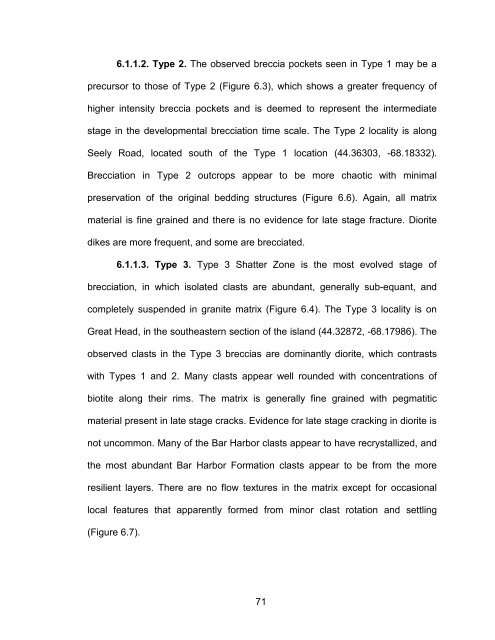You also want an ePaper? Increase the reach of your titles
YUMPU automatically turns print PDFs into web optimized ePapers that Google loves.
6.1.1.2. Type 2. The observed breccia pockets seen in Type 1 may be a<br />
precursor to those <strong>of</strong> Type 2 (Figure 6.3), which shows a greater frequency <strong>of</strong><br />
higher intensity breccia pockets and is deemed to represent the intermediate<br />
stage in the developmental brecciation time scale. The Type 2 locality is along<br />
Seely Road, located south <strong>of</strong> the Type 1 location (44.36303, -68.18332).<br />
Brecciation in Type 2 outcrops appear to be more chaotic with minimal<br />
preservation <strong>of</strong> the original bedding structures (Figure 6.6). Again, all matrix<br />
material is fine grained and there is no evidence for late stage fracture. Diorite<br />
dikes are more frequent, and some are brecciated.<br />
6.1.1.3. Type 3. Type 3 Shatter Zone is the most evolved stage <strong>of</strong><br />
brecciation, in which isolated clasts are abundant, generally sub-equant, and<br />
completely suspended in granite matrix (Figure 6.4). The Type 3 locality is on<br />
Great Head, in the southeastern section <strong>of</strong> the island (44.32872, -68.17986). The<br />
observed clasts in the Type 3 breccias are dominantly diorite, which contrasts<br />
with Types 1 and 2. Many clasts appear well rounded with concentrations <strong>of</strong><br />
biotite along their ri<strong>ms</strong>. The matrix is generally fine grained with pegmatitic<br />
material present in late stage cracks. Evidence for late stage cracking in diorite is<br />
not uncommon. Many <strong>of</strong> the Bar Harbor clasts appear to have recrystallized, and<br />
the most abundant Bar Harbor Formation clasts appear to be from the more<br />
resilient layers. There are no flow textures in the matrix except for occasional<br />
local features that apparently formed from minor clast rotation and settling<br />
(Figure 6.7).<br />
71
















